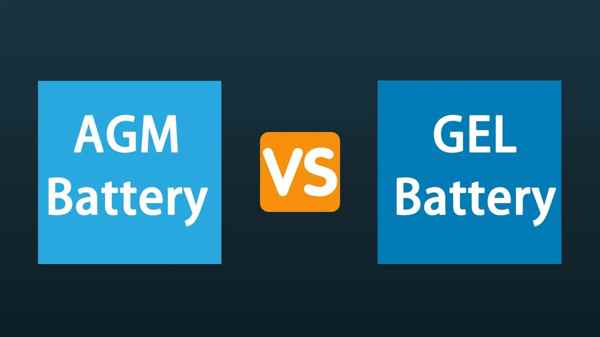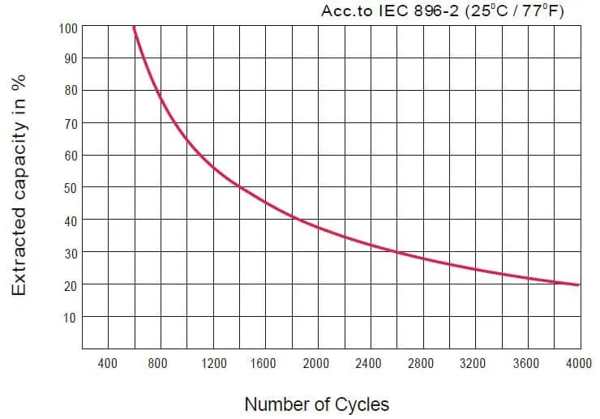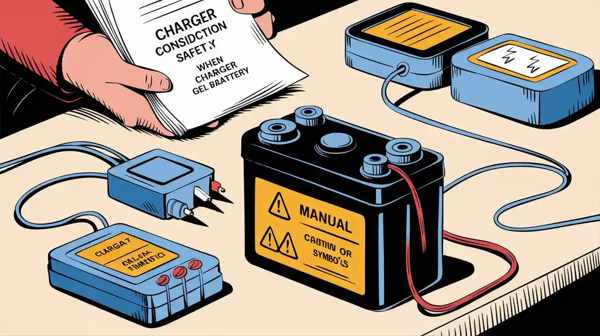哪个更好, AGM或凝胶电池?
当您寻找可靠的, 太阳系的无维护电池, 船, 或备份功率, 您很快就会遇到两个流行的选择: AGM和凝胶. 它们都是密封的铅酸电池的类型, 但是他们在内部使用不同的技术, 这使它们更适合不同的工作. 所以, 哪一个确实更好?
股东大会和凝胶都不是普遍的“更好”; 最佳选择取决于您的特定应用. 简而言之, AGM (吸收玻璃垫子) 电池通常更好地适用于需要高功率输出的应用 (就像启动引擎) 和更快的充电速度。凝胶电池通常会慢慢出色, 深度放电应用,并且可以更宽容很高的环境温度.

在GYCX太阳能, 我们使用各种电池技术, 我们的专业知识在于将正确的电池与合适的工作匹配. 让我们分解AGM和Gel之间的差异,以帮助您做出明智的决定.
AGM电池是铅酸还是凝胶?
所有首字母缩写词, 很容易感到困惑. 是AGM和凝胶竞争技术, 还是他们相关? 让我们澄清电池家谱.
AGM电池是一种 铅酸 电池, 但是他们是 不是 凝胶电池. 想想“铅酸" 作为主要的姓氏. 在那个家庭之下, 您有两个主要分支: 传统的”洪水" 电池 (需要维护) 和“密封的铅酸" 或VRLA电池 (没有维护). AGM和凝胶都是两种不同的密封VRLA电池. 它们之间的关键区别在于它们如何固定内部的酸电解质.

深入潜水: 术语的快速指南
- 铅酸电池: 使用铅板和硫酸电解质的电池的整体类别.
- 铅酸洪水 (fla): 传统, “湿单元" 类型. 将铅板浸入液态酸中, 而且需要定期用蒸馏水来浇灌.
- 密封的铅酸 (VRLA - 阀门调节的铅酸): 无维护类别. 电池密封, 内部气体已重新组合.
- AGM (吸收玻璃垫子): 酸被夹在铅板之间的非常细的玻璃纤维垫所吸收并固定在适当的位置.
- 凝胶: 酸与二氧化硅烟混合以形成厚, 不流动的粘性凝胶.
所以, 两者都密封并不含维护, 他们用来包含酸的方法赋予它们不同的性能特征.
如何判断电池是AGM还是凝胶?
您有密封的铅酸电池, 但是您不确定是AGM还是凝胶. 知道差异至关重要,因为它们需要不同的充电概况. 您如何确定自己的类型?
判断电池是agm还是凝胶的最可靠方法 阅读电池盒上的标签. 大多数制造商会明确打印“ AGM," “吸收性玻璃垫子," “凝胶," 或“凝胶细胞" 在贴纸上. 如果标签已磨损或不清楚, 您的下一个最好的步骤是 在线查找型号 在制造商的网站上. 产品的预期应用也可以是线索.

深入潜水: 您的身份证清单
这是识别电池类型的步骤:
- 仔细阅读标签: 这是最直接的方法. 寻找技术名称. 有时可能只是说“ vrla" 或“密封铅酸”," 在这种情况下,您可能需要更深入地挖掘.
- 搜索型号: 每个电池都有一个型号 (例如, “ 8a31dt" 或“ GPL-31T”). 快速互联网搜索该型号几乎总是会导致您进入指定化学的产品页面或技术数据表.
- 考虑原始申请:
- AGM电池 非常擅长提供高电流, 因此,它们在使用停机技术的高性能车辆中非常普遍, 具有强大音频系统的汽车, 对于海洋或房车引擎启动.
- 凝胶电池 在慢速, 稳定的, 深层排放. 它们经常在电动踏板车中发现, 电动轮椅, 以及一些电信或离网太阳能应用程序.
- 为什么要知道: 您必须知道在智能充电器或太阳充电控制器上选择正确的充电配置文件的类型. 在凝胶电池上使用AGM设置 (或反之亦然) 可能导致收费不足或过度收费, 两者都会缩短电池的寿命.
凝胶电池的寿命是多少?
当您投资 凝胶电池1, 你想知道多少 服务年2 您可以期待. 在适当的护理和正确的条件下, 他们可以是耐用的表演者, 但是他们的生活是有限的.
优质的深循环凝胶电池通常具有 日历寿命 5 到 10 年. 在用法方面, 它可以从任何地方提供 500 结束 1,000 电荷分散周期. 这种寿命不能保证,并且高度取决于几个关键因素, 最值得注意的是 正确充电, 工作温度, 以及它排出的深度 定期.

深入潜水: 决定寿命的因素
您从凝胶电池中获得的实际使用寿命将由这些关键变量确定:
- 充电方法: 正如我们将讨论下一个, 使用正确的凝胶特异性充电概况是最重要的因素. 一致的过度充电或收费不足会大大缩短电池的寿命.
- 工作温度: 热量是所有铅酸电池的敌人. 理想的工作温度约为25°C (77°f). 在像曼谷一样始终如一的炎热气候中, 电池在通风不良的空间中可以看到其使用寿命切成两半.
- 放电深度 (国防部): 这是指您在每个周期中使用的电池容量. 仅排放到的电池 30% 它的容量将持续许多循环,而不是始终出院 80%.
- 如何比较:
- 与. AGM: 当两者都得到很好的治疗时,AGM和凝胶电池的寿命通常是可比的, 尽管凝胶有时可以在循环寿命中略有优势,以减慢, 深层排放, 而对充电不当的耐受性较低.
- 与. 锂 (磷酸铁锂): 差异很大. 现代LFP电池, 哪种GYCX太阳能通常建议太阳能, 提供更长的寿命 (10-20 年和 3,000-6,000+ 周期), 使其成为日常骑自行车应用的卓越长期投资.
凝胶电池需要特殊的充电器吗?
您选择了凝胶电池 无维护的福利3. 您可以使用任何标准的电池充电器将其放在上面吗? 这是一个关键点,错误可能非常昂贵.
是的, 绝对地. 凝胶电池需要兼容的智能充电器,该充电器具有特定的 “凝胶" 充电配置文件. 使用为传统洪水或深循环电池设计的标准充电器几乎可以肯定会随着时间的推移损坏或破坏凝胶电池. 充电电压和算法必须与凝胶化学完全匹配,以确保其健康和寿命.

深入潜水: 为什么正确的充电器不可谈判
这就是为什么凝胶兼容充电器至关重要的原因:
- 防止过电压: 凝胶电池对高压非常敏感. 适当的凝胶配置文件使用较低的电压设定点 (通常在14.1V大约14.4V左右顶部). 标准的电池充电器可能会将电压推向14.8V或更高, 这将“做饭" 凝胶.
- 避免破坏性均衡: 许多用于洪水电池的充电器具有“均衡" 模式, 这是一种受控的过度充电,旨在平衡细胞. 这个过程对凝胶电池具有很高的破坏性. 它导致凝胶电解质中的水分解成从电池中排出的气体. 因为您不能加水, 这永久干燥凝胶, 破坏其能力.
- 多阶段充电: 具有凝胶配置文件的智能充电器使用多阶段算法 (例如, 大部分, 吸收, 漂浮) 这是针对凝胶电池所需的量身定制的. 它有效地充电,然后掉落到安全的“浮动”" 电压以维护电池而不会过多充电.
- 股东也不同: 重要的是要注意,AGM电池还具有自己的特定充电配置文件, 这与凝胶和洪水不同. 一个良好的多化学充电器将为每个充电器提供单独的设置.
GYCX太阳能故事: “我们总是告诉客户,充电器与电池本身一样重要. 当我们设计系统时, 无论是太阳能还是备用电源, 我们确保太阳能电荷控制器或AC充电器完美地编程了用于使用的电池技术. 这保护了客户的投资,并且是我们专业优势的关键部分。"
所以, 更好, AGM或凝胶? 这是一个权衡. 股东大会很棒, 多功能主力, 非常适合高功率和深循环使用. 凝胶是一个专业的深循环表演者,在非常炎热的气候中可以更耐用,但需要更精确的充电. 对于许多现代太阳能应用, 现在的对话包括LFP锂, 提供卓越的寿命和性能.
在 吉克斯太阳能, 我们有专业知识来帮助您浏览这些选择. 我们可以分析您推荐电池技术的需求 - , 凝胶, 或锂 - 将为您的特定应用提供最佳价值和性能. 立即与我们联系以进行专业咨询!
